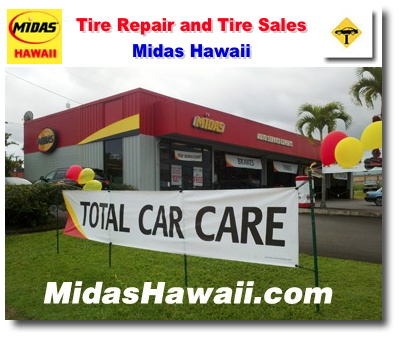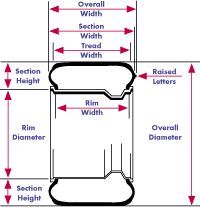Tire Repair and Tire Sales
- Tweet

Tire Repair and Tire Sales
In addition to being North America's leader in brake and exhaust services, Midas provides expert tire service and sales with genuine Sumitomo® tires. Our technicians will inspect, rotate, and balance your tires, as scheduled. And when it's time to replace them, we will determine the correct size and kind of tire you need for the car and type of driving you do. Finally, we will make sure your new tires are properly installed. Need an alignment? We'll take care of that, too.
At Midas, our expert mechanics will inspect, rotate, and balance your tires, as needed. When it's time to replace them, we will determine the right size and model for your needs and see that they are properly installed. Need an alignment? We'll take care of that for you, too.
So, come to Midas Hawaii for tire service...we think you'll find we're a good fit.
And don't forget: manufacturer recommended vehicle maintenance typically includes tire rotation and wheel alignment.
* See shop for applicability and limited guarantee details.
WHEN SHOULD I REPLACE MY TIRES?
According to most states' laws, tires are legally worn out when they have worn down to 2/32" of remaining tread depth. To help warn drivers that their tires have reached that point, tires sold in North America are required to have molded indicators called "wear bars" across their tread pattern from their outside shoulder to inside shoulder. Wear bars are designed to visually connect the elements of the tire's tread pattern and warn drivers when their tires no longer meet minimum tread depth requirements.
However, as a tire wears it is important to realize that while its dry traction and handling will improve...its ability to perform in rain and snow will diminish. At 2/32" of remaining tread depth, resistance to hydroplaning in the rain at highway speeds has been significantly reduced and traction in heavy snow has been virtually eliminated.
If rain and wet roads are a concern, you should consider replacing your tires when they reach approximately 4/32" of remaining tread depth. Since water can't be compressed, you need enough tread depth to allow it to escape through the tire's grooves. If the water can't escape fast enough your vehicle's tires will be forced to hydroplane (actually float) on top of the water, losing traction.
WHAT IS THE RIGHT SIZE FOR MY VEHICLE?
A tire's first requirement is that it must be able to carry the weight of your vehicle. No matter how good a tire you select, if its capabilities are "overworked" just carrying the load, it will have little reserve capacity to help your vehicle respond to quick emergency. So when you are in the selection process, make certain that your new tire's size is designed to carry the weight of your vehicle! Don't undersize.
The other size consideration is overall tire diameter. Since many of the functions of today's vehicles are highly computerized, maintaining accurate speed data going into the computer assures accurate instructions coming out. And an important part of the speed equation is your tire's overall tire diameter. For cars and vans, staying within a ±2% diameter change is desirable.
Some plus sizing on pick-ups and sport utility vehicles (SUVs) has traditionally utilized sizing outside of this ±2% diameter allowance. The critical factors of concern when changing from the Original Equipment size are: 1. to ensure the tires carry the load (and potential load) for the vehicle; 2. to ensure the vehicle stability has not been compromised; 3. the acceleration and braking have not been compromised by the change; and 4. there is no interference of the tires with the body, suspension, or chassis of the vehicle.
Most tire dimensions can be calculated. See the section on "How do I calculate tire dimensions?"
While at first a ±2% diameter increase or reduction in tire diameter may sound very limiting, in most cases it allows approximately a ±1/2" diameter change.
Additionally to help with the selection of substitute sizes, a system called "Plus Sizing" was developed. Use Plus Sizing to take into account the diameters of the available tires and the wheels, and this helps select the appropriate tire width that ensures adequate load capacity. Maintaining the tire's overall diameter helps maintain accurate speed data going into the computer.
HOW MANY TIRES DO I NEED?
Since tires affect the personality and performance of your vehicle, all four tires should be as identical as possible or handling problems may arise. If your tires don't match, it is possible that one end of your vehicle won't respond as quickly or completely as the other, making it more difficult to control.
JUST ONE TIRE?
If your tires have a lot of remaining tread depth, but you need to replace just one that has been damaged by an accident, road hazard or a vandal, you should replace it with a tire that exactly matches the others. Select a replacement tire of the same brand, line, size and speed rating. While there may be a less expensive tire available, it wouldn't be a bargain this time because it would be different than the other three tires on your vehicle.
A PAIR OF TIRES?
If two of your tires have a lot of remaining tread depth, but you need to replace the other two because they were damaged or have worn out, you should replace them with a pair of tires that come as close as possible to matching your existing tires. While identical new tires are desirable, others of the same size and type can also provide good results. Only consider selecting new tires that are from the same tire category as your existing tires. New tires should be installed on the rear axle.
While your vehicle is being serviced ask your mechanic why one pair of tires have worn faster than the other pair. Was it caused by a lack of tire rotation, out-of-spec wheel alignment or loose mechanical parts? Once the problem has been found, it can be corrected before it damages your new tires. Keep in mind that your ultimate goal is that all of your tires always wear out at the same time so they can be replaced as a set.
A SET OF TIRES?
If all of your tires are wearing out together, you have the greatest flexibility in tire selection. If you were happy with the original tires, simply replace them. If you want longer treadwear, a smoother ride or more handling, there are probably tires that will help you accomplish that.
HOW DO I CALCULATE TIRE DIMENSIONS?
Example...185/60R14 85H or 185/60HR14 The first number is the width of the tire in millimeters, measured from sidewall to sidewall. To convert to inches, divide by 25.4 in the example above, the width is 185mm or 7.28".
The second number is the aspect ratio. This is a ratio of sidewall height to width. In the example above, the tire is 7.28" wide, multiply that by the aspect ratio to find the height of one sidewall.
In this case, 185x0.60=111mm or 7.28"x0.60=4.36".
The last number is the diameter of the wheel in inches.
To figure the outside diameter of a tire, take the sidewall height and multiply by 2, (remember that the diameter is made up of 2 sidewalls, the one above the wheel, and the one below the wheel) and add the diameter of the wheel to get your answer.
185mm x .60=111mm x 2=222mm + 355.6mm (14") = 577.6mm or 22.74" (((185 X .60) X 2) / 25.4 ) + 14 = 22.74
A shorter formula exists that makes this a little easier. It is Section Width (SW) times the Aspect Ratio (AR) (full number) divided by 1270 (a constant that takes care of the percentages, the two sidewalls, and the conversion to inches), plus the rim diameter (RD) (in inches), which gives the Outside Diameter (OD). Here is how it would look with the same example above.
((SW X AR) / 1270) + RD = OD
((185 X 60) / 1270) + 14 = 22.74 inches

FAQ LEGEND
Back to the top
New Tires & Tire Services Questions
A. You need new tires, and you have questions. What type of tire do I really need? What do terms like "all-season" and "all-terrain" really mean? What are my financing options?
Midas brings simplicity to tire buying (and owning). We're here to help you with tire selection, financing, professional installation, and preventive maintenance for a long tire life. We even check your tire pressure and tread wear as part of every Midas Touch Courtesy Check1, no matter what auto repair or maintenance service brings you to Midas.
- Midas Touch Courtesy Check also includes visual checks of brakes, battery, air filter, fluids, belts, and hoses. ↩
A. Seasonal Tires - Change these tires twice a year for the best possible tire performance in summer and winter.
- Snow/Winter Tires: The strongest possible winter traction thanks to tread edges that bite into ice and snow, generous channels that send away slush -- and rubber that stays supple at lower temperatures than other tires.
- Summer Tires: Lower rolling resistance (and less fuel consumption) than winter, all-season, or off-road tires thanks to flatter treads (for more road contact) -- and rubber formulated for warmer temperatures.
Related:
When to switch between summer and winter tires
Year-Round Tires - Not into changing tires along with the seasons? These versatile tires balance the features needed for summer and winter driving, on and off the roads.
- All-Season Tires: The tires that come with most passenger cars. Ideal for street driving in areas where winters are moderate (at worst).
- All-Terrain Tires: Multipurpose marvels that balance off-road traction and durability with comfortable, responsive highway handling. Ideal for a mixture of street driving and moderate off-road use.
- Mud Tires: Off-road specialists that power through mud, rocks, sand, dirt, and deep snow. Ideal for primarily off-road use (especially on challenging terrain).
- Low Profile Tires: Enhanced cornering and handling thanks to wide treads and short sidewalls.
- Performance Tires: Excellent traction, maneuverability and performance thanks to soft rubber compounds and stiff sidewalls.
Want the best snow traction in a year-round tire?
Look for the three-peak mountain snowflake (3PMSF) symbol on tires rated for severe snow service. To qualify, a tire must achieve 10% better traction over medium packed snow in manufacturer tests. The mountain snowflake symbol is found on most dedicated snow tires -- and select (year-round) all-terrain and all-season tires. Learn more about severe snow-rated tires.
A. You should replace any tire that shows one or more of these signs of age, damage, or wear:
- Low tread depth: Replace tires that have worn down below the recommended tread depth. The U.S. legal minimum tread depth is 2/32." You may want to replace your tires at a higher tread depth depending on manufacturer recommendations, or your specific driving conditions.
- Sidewall damage: Tires with cracks, punctures, blisters, or bulges in the sidewall are no longer structurally sound and cannot be repaired.
Your local Midas technician can help you identify these tire safety hazards, and help you select your perfect replacement tires.
A. The legal minimum tire tread depth in the United States is 2/32" and many tire experts recommend replacing tires at 4/32"-6/32" tread depth or less, especially for tire types that benefit from a deeper tread (snow tires, all-terrain tires, or mud tires). Testing multiple winter tire brands at 5/32"-6/32" tread depth (or 50% of original tread depth), Consumer Reports saw a 14.5% decline in snow traction when accelerating, and a 7% increase in wet stopping distance compared to the tires' original tread depth2.
How to tell if your tire tread depth is too low, and you need to replace your tires:
- Use a tire tread depth gauge for a precise measurement.
- Take the U.S. Penny Test: Insert a penny (head first) into your tire tread. If you can see the top of Lincoln's head, it's time for new tires. If the top of Lincoln's head is covered, your tread is deeper than 2/32". On the tail side, if the top of the Lincoln Memorial is covered, your tread is deeper than 6/32".
- Take the Canadian nickel test: If the top of Queen Elizabeth's crown is covered, your tread is deeper than 2/32".
- Take the U.S. Quarter Test: If the top of Washington's head is covered, your tire tread is deeper than 4/32".
- Take the Canadian Quarter Test: If the caribou's nose is covered, your tire tread is deeper than 6/32".
- Check the wear bars: Tire wear bars are situated at 2/32" of tread depth, so if any wear bar is worn, replace the tire right away. It's below the legal minimum tread depth.
Check tread depth on several parts of the tire, especially if you see uneven wear patterns. And talk to a Midas tire expert to help you decide how low your tread depth can go.
A. It's a good idea to have your wheel alignment checked when you buy new tires, to ensure that your new tires wear down evenly from the day you drive them home. We also recommend having your alignment checked regularly to extend the life of your tires -- it's especially convenient to do this when your vehicle is in for services like tire rotation.
Related:
Learn more about Wheel Alignment
A. While tire imbalance is a common side effect of bumpy roads and other driving hazards, new tires should be checked for balance before mounting. Even new tires can have natural imbalance from the factory. Starting off with balanced tires and having the balanced checked as a regular part of tire service will help extend the life of your tires.
Related:
Learn more about Tire Balancing
A. Midas recommends installing a TPMS Service Kit with every tire purchased on a TPMS sensor vehicle and testing the TPMS sensor to ensure it's measuring your tire pressure correctly. Maintaining proper tire pressure extends the life of your tires by preventing premature edge wear and other damage. And your TPMS system is there to alert you to dangerously low tire pressure -- and the blowout risk it brings. You don't want to miss this warning due to incorrect pressure measurements or a malfunction in your TPMS's alert function.
Related:
Learn more about TPMS
ref no:9543
Please send questions about this website to webmaster
Terms of Use / Legal Disclaimer / Privacy Statement
Site Designed and Managed by MacBusiness Consulting



